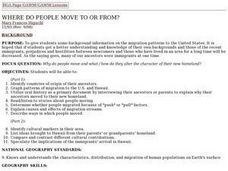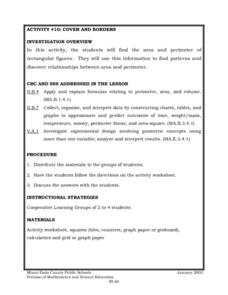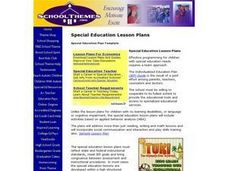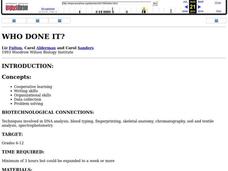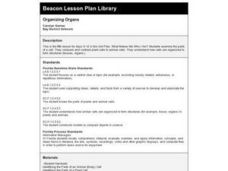Curated OER
Investigation - Looking For Triangles
Seventh graders investigate a series of triangles, looking for patterns and generalizing what they have found. They analyze the pattern data and organize it into a table and graph. Students identify the relationship and discover the rule...
Curated OER
Count on Me
Fourth graders use inductive reasoning to find algebraic patterns in geometric figures. They use technology (i.e., calculators, computers) and manipulatives to discover number patterns involving geometric concepts. They solve concrete...
Curated OER
Trembling, Spewing Earth: Impacts on Human Activity
Seventh graders study to identify patterns in earthquake activity and impacts on human behavior. They also develop plans to cope with such natural disasters.
Curated OER
Where Do People Move To Or From?
Students identify countries of origin of their ancestors, graph patterns of migration to the U.S. and Hawaii, then utilize oral history as a primary document by interviewing their ancestors or parents to explain why they moved to their...
Curated OER
Wow! You're Eating Geography
Young scholars examine patterns of food producing areas, and identify foods that are grown locally, in the U.S., and around the world. They map and graph the major food crops of their local area, the U.S., and other countries, and...
Curated OER
Plant Diversity and Distribution
Students construct a defined plot on school grounds and observed patterns in plant life. They count trees, shrubs, cacti and record on a data sheet. They compare data and generate a plant diversity overlook for their school.
Curated OER
Rain Forests: A Disappearing Act?
Students examine and locate rainforests on maps, and research the patterns of their destruction. They develop a bar graph of rainfall and temperature data, write a journal entry, and research the people, animals, and plants/products of...
Curated OER
Indians of the Pacific Northwest
Students organize acquired information and make inferences as to the kind of habitat and its probable location. They identify and replicate art forms characteristic of the Pacific Northwest coast involving the use of ovoids and "u forms".
Curated OER
Researching and gathering information
Though text heavy, these nine slides present clear instructions for each stage of the research method that students should use to organize information about Saguaro Cacti. A good introduction to organizing research for a writing...
Curated OER
Check it Out...Nonfiction Can Be Fun!
Organizing information gathered for a research topic can be a challenge. Read aloud notes you have collected on a topic and use suggestions offer by the class to categorize and sort this information. Partners then follow this pattern,...
Curated OER
Cover and Boarders
Students find the area and perimeter of rectangular figures. They use this information to find patterns and discover relationships between area and perimeter. Students apply and explain formulas relating to perimeter, area, and volume.
Curated OER
Write like David Shannon
Students distinguish various books by David Shannon from other authors, compare three of Shannon's books for similarities, list various possible settings for stories, integrate Shannon's pattern of writing into their own, and formulate...
Curated OER
Life Comes in Cycles
Kids are fascinated by chickens and their eggs. Here is a learning exercise has young learners take a look at the four stages in a chicken's life cycle. They have four cycles to organize: egg, chick, young bird, and adult. They have to...
Curated OER
Special Education Plan
Special needs students practice completing everyday tasks such as organizing a day plan, reading a clock and completing simple math problems. They define the proper learning techniques for their disorder and utilize props in...
Curated OER
Graphing Activity
In this probability and statistics worksheet, students work with a family member to construct graphs based on real life data. The two page worksheet contains three questions. Answers are not included.
Curated OER
Who Done It?
Students work in groups to solve various murder mysteries using DNA evidence to implicate suspects. Teams compete to solve the crimes the fastest, while using various scientific methods to accomplish their task.
Pennsylvania Department of Education
6 Traits: Sentence Fluency
Students practice writing with sentence fluency in order to make the story more enjoyable for the reader. In this sentence fluency lesson plan, students focus on rhythm and flow.
Curated OER
Job Interview
Eighth graders write a multi paragraphed, expository composition that explanins how one would conduct themself before, during, and after a job interview. In order to be prepared for the interview, 8th graders complete a thesis, have an...
Curated OER
All's Well That Ends Well
Students examine and discuss the parts of a speech and how to organize them. They read sample speeches, then write a short presentation to read to the class, identifying the beginning, middle, and ending of their speech.
Curated OER
Essential to Autumn: Line, Shape, Color, Texture, Pattern, Rhythm, Emphasis, Movement, Balance, and Unity
Young scholars explore the environment by learning about nature. In this art lesson, students go on a walk and find objects to help in creating a picture, or collage representing whatever season is being discussed. Young scholars...
Curated OER
Organizing Organs
Fifth graders research plant and animals cells and create a Venn Diagram to show the similarities and differences.
Curated OER
Dance Sequences and Phrases
A series of lessons about dance would be a great addition to your physical education class. Straightforward as well as creative, it teaches the basic skills of dance movement. A rubric helps guide the dancers to let them know what steps...
Curated OER
Sequencing
Are you looking for a way to teach sequence of events in your narrative writing unit? Bring this lesson to your middle school class, as it prompts young writers to create a narrative sequence map of events that have happened at school...



